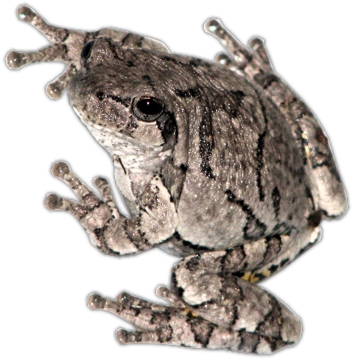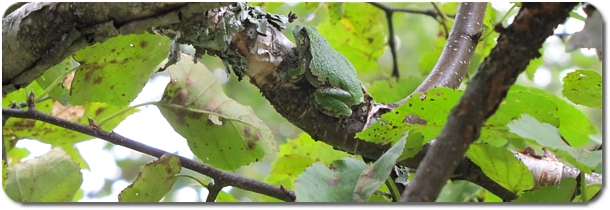Gray Treefrog and Cope's Gray Treefrog

Strange Stuff!
There are really two kinds of Gray Treefrogs, but you can't tell them apart by looking at them! One is called the Gray Treefrog and the other is called the Cope's Gray Treefrog. They have different numbers of chromosomes (the strings of DNA) in the cells of their bodies, but they look and act the same! You can only tell them apart if you hear their mating calls. So here they are both just called the Gray Treefrog.
What it looks like
The Gray Treefrog is a medium sized treefrog. An adult can have a body that is up to 6 cm long. Gray Treefrogs can change colour. The tops of the body can be any colour from very dark gray to bright green. They can have stripes and blotches of colours or they can be one colour all over. The belly can be light gray to white. On the inside of the hind leg is a bright yellow patch. The tips of their toes have little pads like suckers on them.
Look-alikes
A large Gray Treefrog might look a little like a Canadian or American Toad, but the toads will be brown, not gray, and have lots of warts. The yellow patch on its hind leg is something that toads don't have. A small Gray Treefrog can look a lot like a Spring Peeper or a Boreal Chorus Frog, but these have thinner bodies and don't have the yellow leg patch.
Name
The Gray Treefrog gets its name because it is usually gray in colour, and lives in trees. Cope's Gray Treefrog is named for Edward Drinker Cope, a famous biologist who first described the species.
Scientific Name
The Gray Treefrog's scientific name is Hyla versicolor. Cope's Gray Treefrog is Hyla chrysoscelis. Learn what these mean on this page: Scientific Names.
Where it lives
Gray Treefrogs live in forests and they usually stay close to small ponds or wetlands. They live in eastern North America, from southern Canada to the Gulf of Mexico. They are found in southern Manitoba as far north as the middle of Lake Winnipeg.
Where Gray Treefrogs live in North America.
Habits
In the day time, Gray Treefrogs rest on the branches or leaves of trees. They are active at night and will crawl through the trees looking for food. They usually hunt by sitting still and waiting for an insect to fly or crawl close by. In late autumn they leave the trees and crawl under the leaves on the forest floor. They spend winter there and their bodies freeze solid.

Gray Treefrogs can hide in plain sight.
Food Web
Gray Treefrogs eat insects such as moths, small beetles and flies that are active at night up in the trees.
Small owls and squirrels would probably eat adult Gray Treefrogs if they found them in the trees. Snakes could catch ones that were near the ground. The tadpoles are eaten by large water insects, snakes, and wading birds like herons.
Life Cycle
Gray Treefrogs mate and lay eggs in May or early June. They breed in ponds filled by melting snow and rain or in small year-round ponds. Males pick a spot to call for mates in a small tree or bush near the water.
Hear the Cope's Gray Treefrog mating call: |
Hear the Gray Treefrog mating call: |
Females move to the pond when they have found a mate and lay their eggs quickly in a small bunch on some plants or sticks in the water. The eggs hatch in 3 to 5 days. The tadpoles can change to treefroglets after about 40 days, by mid-July. The new treefroglets are about 1.5 cm long.
Numbers
Gray Treefrogs are common in most parts of southern Manitoba, but no one knows how many there might be in one hectare of forest.
Special Things
The sticky toe pads on the tips of the toes of Gray Treefrogs help them to climb through branches and stick onto leaves. They can freeze solid in winter, under the forest floor leaves, so they can live in places that only have small ponds that dry up by late summer.
Maybe the most special thing about Gray Treefrogs is the way they can change colour to hide from their enemies. They can turn gray to hide on a gray tree trunk or change to green to hide on a leaf. They are Manitoba's chameleons!
How to Find Gray Treefrogs
Listen for males calling from mid-May to mid-June. Evening is the best time to hear them, but they will call during the day, too. Gray Treefrogs live in trees, so look for them up off the ground. They are often found near bright lights at night where they hunt insects attracted to the lights. Look for them at night on lighted phone booths or other structures with lights in forested areas.
Use by People
Treefrogs are very hard to find, so they probably aren't used by people.
| Next treefrog: Spring Peeper | Back to: Amphibians and Reptiles Front Page |
